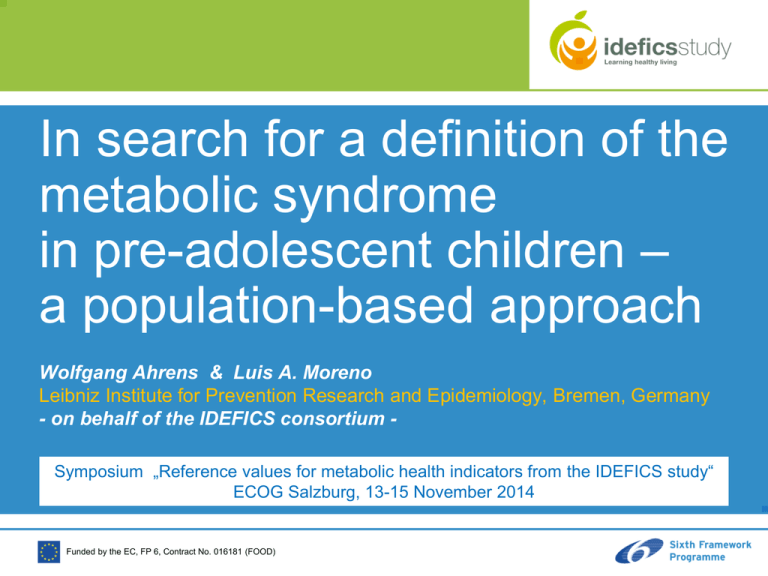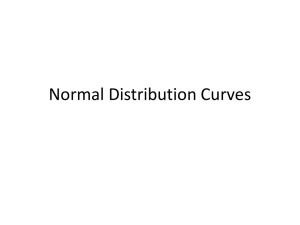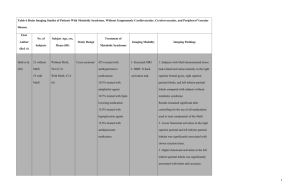
In search for a definition of the
metabolic syndrome
in pre-adolescent children –
a population-based approach
Wolfgang Ahrens & Luis A. Moreno
Leibniz Institute for Prevention Research and Epidemiology, Bremen, Germany
- on behalf of the IDEFICS consortium Symposium „Reference values for metabolic health indicators from the IDEFICS study“
ECOG Salzburg, 13-15 November 2014
Funded by the EC, FP 6, Contract No. 016181 (FOOD)
Complications of obesity in children
Ebbeling CB et al. Lancet 2002; 360: 473-482
Metabolic syndrome in children
Cardiovascular risk factors tend to cluster
Webber LS et al. Prev Med 1979; 8: 407-418
Chu NF et al. Am J Clin Nutr 1998; 67: 1141-1146.
8.9 % of obese children have the metabolic syndrome
Csábi G et al. Eur J Pediatr 2000; 159: 91-94.
Factor analysis of metabolic syndrome components show 2-4 factors
Chen W et al. Am J Epidemiol 1999; 150: 667-674
Moreno LA et al. Horm Metab Res 2002; 34: 394-399
The most frequent components of
the metabolic syndrome (MetS)
Obesity
Hypertension
Dyslipidaemia (high triglyceride and low HDL-C concentrations)
Insulin resistance – hyperinsulinemia – glucose intolerance
and/or type 2 diabetes
Hansen BC. Ann N Y Acad Sci 1999; 892: 1-24
Correlation between waist circumference
and visceral fat assessed by magnetic
resonance imaging
16 0
Y = 1.1*X - 5 2.9
R2 = 0 .64, p < 0.00 01
14 0
RMSE = 14 cm 2 (33 %)
V A T (cm 2 )
12 0
10 0
80
60
40
20
0
0
40
80
12 0
16 0
WC (cm )
Luis A. Moreno Aznar
lmoreno@unizar.es
Brambilla P, Bedogni G, Moreno LA et al. Int J Obes 2006; 30: 23-30
GENUD Research Group
Universidad de Zaragoza
110
Girls
100
90
US
UK
Spain
Canada
Adults
80
70
60
50
40
2
4
6
8
10
12
14
16
18
Waist circumference (cm)
Waist circumference (cm)
Different reference standards for waist
circumference (90th percentile)
110
Boys
100
90
US
UK
Spain
Canada
Adults
80
70
60
50
40
2
Age (years)
Luis A. Moreno Aznar
lmoreno@unizar.es
Brambilla
P
et
al.
Int
J Obes 2007;
591-600
GENUD Research Group
Universidad
de31:
Zaragoza
4
6
8
10
12
Age (years)
14
16
18
Lipoprotein metabolism
Lusis AJ et al. Circulation 2004; 110: 1868-1873
Natural history of type 2 diabetes
Obesity
Insulin sensitive
Diet
Sedentary lifestyle
NORMOGLYCEMIA
Genetics
Perinatal factors
Insulin resistance
Compensatory hyperinsulinaemia
b-cell decompensation
Relative insulin deficiency
POSTPRANDIAL
HYPERGLYCEMIA
IMPAIRED FASTING
GLUCOSE
b-cell failure
DIABETES
MELLITUS
Ludwig & Ebbeling. JAMA 2001; 286: 1427-1430
Vascular
complications
Insulin resistance
Homeostatic model assessment (HOMA): the product of the
fasting plasma insulin level (mU/ml) and the fasting plasma
glucose level (mmol/l), divided by 22.5.
Lower insulin-resistance values indicate a higher insulin
sensitivity, whereas higher values indicate a lower insulin
sensitivity.
Definitions of paediatric
metabolic syndrome (MetS) in children
Definition
Excess
adiposity
WC 90th
percentile
Blood pressure
SBP or DBP 90th Triacylglycerols 110 mg/dl
percentile
or
HDL cholesterol ≤ 40 mg/dl
Impaired fasting glucose 110
mg/dl
Viner et al.
BMI 95th
percentile
SBP 95th
percentile
Hyperinsulinemia 15 mU/l
or
Impaired fasting glucose 110
mg/dl
IDF*
WC 90th
percentile
SBP 130 mmHg
or
DBP 85 mmHg
Cook et al.
Blood lipids
Triacylglycerols 150 mg/dl
or
HDL cholesterol <35 mg/dl
or
High total cholesterol 95th
percentile
Triacylglycerols 150 mg/dl
or
HDL cholesterol 40 mg/dl
Blood glucose/ insulin
Impaired fasting glucose 110
mg/dl
Cook S et al.. Prevalence of a metabolic syndrome phenotype in adolescents: findings from the third National Health
and Nutrition Examination Survey, 1988–1994. Arch Pediatr Adolesc Med 2003; 157: 821-827.
Viner RM et al.. Prevalence of the insulin resistance syndrome in obesity. Arch Dis Child 2005; 90: 10-14.
Zimmet P et al.; IDF Consensus Group: The metabolic syndrome in children and adolescents – an IDF consensus
report. Pediatr Diabetes 2007; 8: 299-306.
*IDF=International Diabetes Federation
Metabolic syndrome in children?
Background:
Pediatricians should consider a novel
and specific approach to assessing
children/adolescents and should not
simply derive or adapt definitions
from adults. Evaluation of insulin and
lipid levels should be included only
when specific references for the
relation of age, gender, pubertal
status and ethnic origin to health risk
become available.
The diagnostic criteria of the metabolic syndrome (MS) have been applied in studies of obese adults to estimate the metabolic risk-associated with
obesity, even though no general consensus exists concerning its definition and clinical value. We reviewed the current literature on the MS, focusing
on those studies that used the MS diagnostic criteria to analyze children, and we observed extreme heterogeneity for the sets of variables and cutoff
values chosen.
Objectives:
To discuss concerns regarding the use of the existing definition of the MS (as defined in adults) in children and adolescents, analyzing the scientific
evidence needed to detect a clustering of cardiovascular risk-factors. Finally, we propose a new methodological approach for estimating metabolic
risk-factor clustering in children and adolescents.
Results:
Major concerns were the lack of information on the background derived from a child's family and personal history; the lack of consensus on insulin
levels, lipid parameters, markers of inflammation or steato-hepatitis; the lack of an additive relevant effect of the MS definition to obesity per se. We
propose the adoption of 10 evidence-based items from which to quantify metabolic risk-factor clustering, collected in a multilevel Metabolic Individual
Risk-factor And CLustering Estimation (MIRACLE) approach, and thus avoiding the use of the current MS term in children.
Conclusion:
Pediatricians should consider a novel and specific approach to assessing children/adolescents and should not simply derive or adapt definitions from
adults. Evaluation of insulin and lipid levels should be included only when specific references for the relation of age, gender, pubertal status and ethnic
origin to health risk become available. This new approach could be useful for improving the overall quality of patient evaluation and for optimizing the
use of the limited resources available facing to the obesity epidemic.
Brambilla P et al. Int J Obes 2007; 31: 591-600
Prevalence of each component of MetS
according to different definitions (1 of 5)
30%
Cook et al.32
25%
20%
Girls
15%
Boys
10%
5%
0%
WC
BP
Lipids
Glucose
Ahrens W & Moreno LA et al. Int J Obes 2014; 38: S4-S14
MetS
Prevalence of each component of MetS
according to different definitions (2 of 5)
30%
Viner et al.33
25%
20%
Girls
15%
Boys
10%
5%
0%
BMI
BP
Lipids
Glucose
Ahrens W & Moreno LA et al. Int J Obes 2014; 38: S4-S14
MetS
Prevalence of each component of MetS
according to different definitions (3 of 5)
30%
IDF34
25%
20%
Girls
15%
Boys
10%
5%
0%
WC
BP
Lipids
Glucose
Ahrens W & Moreno LA et al. Int J Obes 2014; 38: S4-S14
MetS
Definitions of paediatric
metabolic syndrome (MetS)
Definition
Excess
adiposity
WC 90th
percentile
Blood pressure
SBP or DBP 90th Triacylglycerols 110 mg/dl
percentile
or
HDL cholesterol ≤ 40 mg/dl
Impaired fasting glucose 110
mg/dl
Viner et al.
BMI 95th
percentile
SBP 95th
percentile
Hyperinsulinemia 15 mU/l
or
Impaired fasting glucose 110
mg/dl
IDF*
WC 90th
percentile
SBP 130 mmHg
or
DBP 85 mmHg
Triacylglycerols 150 mg/dl
or
HDL cholesterol <35 mg/dl
or
High total cholesterol 95th
percentile
Triacylglycerols 150 mg/dl
or
HDL cholesterol 40 mg/dl
SBP 90th
percentile or
DBP 90th
percentile
SBP 95th
percentile or
DBP 95th
percentile
Triacylglycerols 90th
percentile or
HDL cholesterol ≤ 10th
percentile
Triacylglycerols 95th
percentile or
HDL cholesterol ≤ 5th
percentile
HOMA-insulin resistance 90th
percentile or
Fasting glucose 90th percentile
Cook et al.
IDEFICS- WC 90th
monitoring percentile
level
IDEFICSaction
level
WC 95th
percentile
Blood lipids
*IDF=International Diabetes Federation
Blood glucose/ insulin
Impaired fasting glucose 110
mg/dl
HOMA-insulin resistance 95th
percentile or
Fasting glucose 95th percentile
Prevalence of each component of MetS
according to different definitions (4 of 5)
30%
IDEFICS-monitoring level
25%
20%
Girls
15%
Boys
10%
5%
0%
WC
BP
Lipids
Glucose
Ahrens W & Moreno LA et al. Int J Obes 2014; 38: S4-S14
MetS
Prevalence of each component of MetS
according to different definitions (5 of 5)
30%
IDEFICS-action level
25%
20%
Girls
15%
Boys
10%
5%
0%
WC
BP
Lipids
Glucose
Ahrens W & Moreno LA et al. Int J Obes 2014; 38: S4-S14
MetS
Prevalence of MetS in normal weight/
thin, overweight and obese children
MetS monitoring -
MetS monitoring +
MetS action -
100%
100%
90%
90%
80%
80%
70%
70%
60%
60%
50%
50%
40%
40%
30%
30%
20%
20%
10%
10%
0%
0%
Normal/ thin
Overweight
Obese
MetS monitoring level = 5.5%
18
Normal/ thin
MetS action +
Overweight
Obese
MetS action level = 1.8%
Ahrens W & Moreno LA et al. Int J Obes 2014; 38: S4-S14
19
Number of MetS risk variables and
elasticity of common carotid artery
Increasing stiffness
Bogalusa Study
Ep = Peterson's elastic modulus
YEM = relative wall thickness-adjusted Young's elastic modulus
Urbina EM et al. Atherosclerosis 2004; 176: 157-164
Calculation of a MetS score
Continuous MetS score calculated according to Eisenmann as the sum
of component z-scores:
Adiposity: WC (waist circumference (cm))
Blood pressure: mean of SBP and DBP (systolic / diastolic blood
pressure (mm Hg))
Blood lipids: mean of TRG and negative HDL (triglycerides / HDL
cholesterol (mg/dl))
Insulin resistance: HOMA (homeostasis model assessment)
zSBP + zDBP zTRG – zHDL
MetS score = zWC +
+
+ zHOMA
2
2
21
Eisenmann JC. Cardiovasc Diabetol 2008; 7: 17
Ahrens W & Moreno LA et al. Int J Obes 2014; 38: S4-S14
Calculation of a MetS score:
four examples
Measured values
Subject Sex Age WC
Standardised residuals (z-scores)
SBP
DBP TRG HDL HOMA
zWC
zSBP
zDBP
1
M
6.5 59.5
109.0
67.5
48
38
0.65
1.66
2
F
5.8 60.4
92.0
52.5
50
52
1.59
2.20 -0.96 -1.77
3
F
5.2 53.0
94.0
58.0
45
61
4
M
5.5 57.5
99.0
66.0
78
45
22
0.85
zHDL zHOMA
MetS
score
0.29 -1.22 -0.15
3.05
0.17 0.10
1.39
2.26
1.00
0.58 -0.51 -0.81 -0.73 0.88
0.68
-0.07
0.99
1.64 -0.13
0.71
3.43
Ahrens W & Moreno LA et al. Int J Obes 2014; 38: S4-S14
0.72
zTRG
0.59
1.15 -0.54
Age-specific reference curves for MetS
in girls and boys
23
Ahrens W & Moreno LA et al. Int J Obes 2014; 38: S4-S14
Conclusions
We propose sex- and age-specific standards for the most
frequent cardio-metabolic features associated with obesity
in children under 11 years
We propose a new definition of MetS to support clinical
decision making
According to different definitions of paediatric MetS, we
classify a non-negligible proportion of mostly pre-pubertal
children as being affected
NOTE: The proposed cut-offs are based on a statistical
definition that does not yet allow to quantify the risk of
subsequent disease
We propose a continuous MetS score to improve
quantitative risk assessment for various clinical endpoints
The IDEFICS Consortium
Thank you!
25
25
Previous achievements
26
Prevalence of MetS in normal weight/
thin, overweight and obese children
100%
80%
60%
Obese
Overweight
Normal/ thin
40%
20%
0%
MetS
MetS
MetS action MetS action
monitoring - monitoring +
+
27
Ahrens W & Moreno LA et al. Int J Obes 2014; 38: S4-S14
International Obesity Task Force (IOTF)
body mass index cut-offs for overweight
and obesity in youth
Girls
30
30
28
28
26
25
30
24
22
20
26
22
20
18
16
16
2
4
6
8
10
12
14
16
18
20
25
30
24
18
0
Boys
32
BMI (kg/m2)
BMI (kg/m2)
32
0
2
4
Age (years)
Luis A. Moreno Aznar
lmoreno@unizar.es
(Cole
TJ
et
al.
BMJ
2000; 320:
GENUD Research Group
Universidad
de1240-1243)
Zaragoza
6
8
10
12
Age (years)
14
16
18
20







